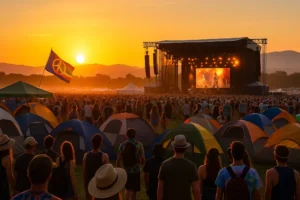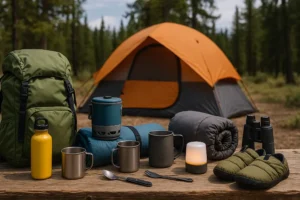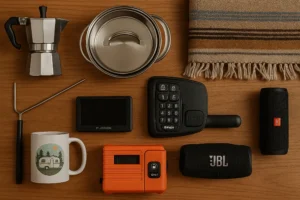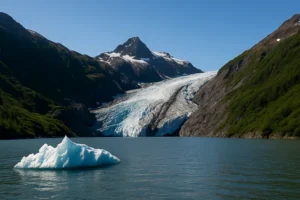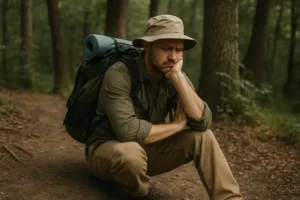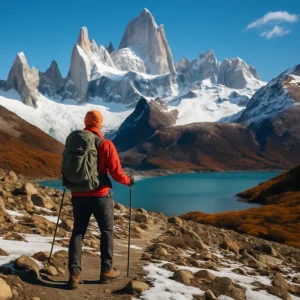The Mount Hua Shan experience is a journey that blends raw physical challenge, breathtaking scenery, and deep cultural roots. Often labeled “the world’s most dangerous hike,” it’s also one of China’s most sacred Daoist mountains, famed for its five distinct peaks. People come for different reasons, some seek spiritual connection, others crave the adrenaline rush of its cliffside paths. I went for something else entirely: the chance to stand on one of the country’s most storied summits and feel the weight of its history under my boots.
The Road to a Sacred Mountain
My trip began not with a hike, but with a motorbike ride from the bustling city to the mountain’s rural foothills. About 120 kilometers east of the city, the road was straightforward and smooth, without much in the way of dramatic views. But the change in atmosphere was instant. Towering glass buildings gave way to low, unfinished houses. The pace slowed. Life here felt simpler.
Before departure, there was a small setback, a slippery tire that needed replacing. It was a reminder that on a long, solo journey, safety comes first. With new tires fitted, I could focus on the road ahead, my pack strapped securely and gear ready for the climb.
A Complicated Start
One thing to know: visiting Mount Hua Shan isn’t as straightforward as just walking up to a trailhead. You don’t simply buy one ticket and go. The system is multi-layered, entrance tickets, bus tickets, and separate cable car tickets. You also have to decide which peak to start from and where you’ll return, because the mountain’s five peaks are connected by long, demanding trails. Without a plan, you might end up stranded on the wrong side as daylight fades.
My plan was to take a bus from the base to the cable car station, ascend to the North Peak, hike across to the South Peak, and return the same way. Starting early is key. On weekdays, the crowds thin out, and you can glide through the ticket counters without much waiting. If you’re carrying extra layers, snacks, or even a compact tent for an overnight stay, factor that weight into your pace.
The First Ascent: North Peak
The bus ride from the visitor center to the base was scenic enough to make me wish I could have ridden my motorbike up instead, but private vehicles aren’t allowed. From there, the cable car whisked me up in about ten minutes, delivering me right to the North Peak.
It’s the easiest peak to reach thanks to its proximity to the cable car, but it still stuns you from the moment you arrive. Sharp ridges rise out of clouds. Valleys drop away into nothingness. This is where the hike begins in earnest.
Two Ways Up: Ancient or Modern
From the North Peak, the trail forks into two styles of ascent. The ancient route is a steep, narrow path carved into the rock, a direct link to the mountain’s history. The modern route is a safer, wider set of stairs. Both climb relentlessly, step after step, cutting upward into thinner air.
Each choice tells a story: the ancient path demands a more primal connection to the mountain, while the stairs make the journey more accessible without erasing the challenge.
The Spiritual Weight of the Place
Mount Hua Shan is not just rock and stone, it’s a living archive of China’s spiritual tradition. Daoist temples cling to cliffsides, some standing alone in seemingly impossible locations. For many, this climb is a form of pilgrimage. The terrain itself is said to represent the spiritual path: steep, narrow, exhausting, but ultimately rewarding.
As I climbed, I felt the energy of the place. The mix of silence, wind, and distant temple bells was grounding. I wasn’t here for adrenaline alone. I was here to stand in a space that has inspired devotion for centuries.
When the Stairs Become Endless
The climb between peaks is no gentle stroll. Thousands of stone steps twist up and down like an unending spine along the mountain’s ridges. The gradient is brutal in sections. I passed groups resting against the rock, catching their breath, sweat soaking their shirts.
This is where pacing matters. Hydrate often. Take breaks before you’re too tired. Don’t underestimate the time needed to traverse between peaks, the trails are longer than they appear on the map. Lightweight trekking poles and a breathable pack can make this part far more manageable.
Aerial Views and Tourist Fun
Somewhere between peaks, I had the rare opportunity to launch a drone. The aerial perspective was unreal: sharp ridgelines, white clouds rolling over green valleys, temples perched like chess pieces on impossible squares.
There’s also a lighthearted side to the mountain. Vendors offer photo opportunities with traditional swords. I gave in, partly to thank the person who allowed me to fly the drone. The result? A few fun, slightly over-the-top souvenir shots to remember the day.
Peak-Hopping: East to South
From the North Peak, I worked my way toward the East Peak, stopping briefly for a local-style “Chinese hamburger.” Each peak offers a different angle on the same dramatic landscape, some higher, some with sweeping valley views, others with close-up cliff faces.
Finally, I reached the South Peak, the highest point on Mount Hua Shan at 2,155 meters. The summit coin I picked up here is now one of my most treasured keepsakes from the trip. If I’d had a tent, I might have stayed the night just to watch sunrise spill across the ridges.
The “World’s Most Dangerous” Section
Mount Hua Shan’s most infamous attraction is the Plank Road in the Sky, a narrow wooden path bolted into a vertical cliff face. While it looks terrifying in photos, it’s actually quite safe with modern harnesses. On my visit, it was closed. For some travelers, that was crushing news, especially those who had come specifically for it. For me, it was just another reminder that you can’t control everything about a journey.
Staying on the Mountain
One surprise was discovering the capsule hotel accommodations high up on the peaks. Imagine waking up to a sunrise over cliffs and temples. It’s not luxury, but it’s a rare chance to immerse yourself fully in the mountain’s atmosphere overnight. For those bringing ultralight camping gear, check local rules before setting up a tent, certain areas are off-limits.
Expectation vs. Reality
I came to Mount Hua Shan expecting something purely sacred, an experience like a previous visit I’d made to another Daoist mountain. But this was different. It was more touristy, more adrenaline-focused, yet still spiritual in moments.
This is where Daoist philosophy whispered its lesson: Wu Wei, the art of going with the flow. Letting go of fixed expectations allowed me to enjoy the experience for what it was, a blend of physical challenge, cultural depth, and playful moments.
Descent and Departure
The journey down mirrored the way up, South Peak back to North Peak, cable car down, bus to the base. My legs ached, but my mind was calm. This wasn’t just a hike; it was a layered experience with history, culture, and a dash of unpredictability.
Whether you come for the spirituality, the scenery, or the thrill of narrow trails, Mount Hua Shan has a way of leaving an impression. It’s a place that tests your legs, your lungs, and even your gear.
Tips for Hiking Mount Hua Shan
1. Start Early
Beat the crowds, especially on weekends. Arriving at the visitor center before 7 a.m. is ideal.
2. Plan Your Route
Decide your starting peak and return point ahead of time to avoid being stranded or rushed.
3. Prepare for the Stairs
Thousands of steep steps mean good cardio, leg strength, and supportive shoes will serve you well.
4. Budget for Multiple Tickets
Entrance, bus, and cable cars are all priced separately, bring cash or mobile payment options.
5. Stay Hydrated and Fueled
Carry a water bottle, energy snacks, and a comfortable pack to keep essentials within reach.
6. Don’t Rely on Attractions Being Open
Sections like the Plank Road can close without warning, so have a backup plan for your day.
7. Gear Up Wisely
Wear reliable hiking shoes with good grip, use trekking poles if needed, and bring a lightweight tent if planning to camp in approved areas.
Final Thoughts
Mount Hua Shan is a mountain of contrasts. It’s sacred and touristic. Dangerous-looking yet surprisingly safe in parts. Exhausting, but rewarding beyond measure.
If you make the climb, you’ll remember the sharp ridges, the long staircases, the temples perched on cliffs. But more than that, you’ll remember how you felt up there, small against the peaks, connected to something timeless, and grateful for every step.
FAQs
Mount Hua Shan is about 120 kilometers east of Xi’an, China. It’s one of the country’s five sacred Daoist mountains, famous for its dramatic peaks.
The mountain has five main peaks—North, South, East, West, and Central. Each offers unique views and varying levels of hiking difficulty.
Visitors typically take a bus from the main visitor center to the cable car station. From there, you can ride up to the North Peak to begin your hike.
Some sections, like the Plank Road in the Sky, look dangerous but are generally safe with modern safety measures. However, the steep stairs and narrow paths can be challenging for those unprepared.
Costs vary but typically include separate fees for entrance, bus, and cable cars. Expect to pay for each segment of transport individually rather than one all-inclusive ticket.
Yes. There are basic accommodations like capsule hotels located high on the mountain, offering unique sunrise views over the peaks.
Weekdays, especially early mornings, are best to avoid heavy crowds. Spring and autumn offer the most comfortable weather for hiking.



